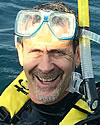 Andrew S. Cohen |
2015 Israel C. Russell Award
Presented to Andrew S. Cohen
Citation by Lisa Park Boush
I am pleased to honor Dr. Andrew (Andy) Cohen as the 2015 Israel Russell Awardee. Andy embodies the spirit of this award by his landmark achievements in research, scholarship, training, and service to the limnogeological community.
Andy’s research has spanned three continents involving all aspects of the limnogeological record. He has co-authored over 114 papers and authored the leading paleolimnology textbook, “Paleolimnology. History and Evolution of Lake Systems”. His efforts in conservation paleolimnology, climate change and human origin research have made an extraordinary impact in those areas for the past three decades.
For the past 25 years, Andy has been a major force in developing scientific lake drilling, leading/co-leading 3 major drilling projects, including the GLAD development and testing project at Great Salt Lake, the Lake Malawi Drilling Project and now, the Hominin Sites and Paleolakes Drilling Project (HSPDP), where he is coordinating >100 scientists from 11 countries, with 5 drill areas in two countries. In addition, he has served on the DOSECC Board of Directors, the ICDP Science Advisory Group and ICDP Lakes Drilling Task Force.
Andy also played a pioneering role in lake management and conservation related to Lake Tanganyika, organizing the first conference and leading the first scoping mission for the UN-GEF Lake Tanganyika conservation project. In addition, he has trained over 100 American and 100 African students in his Research Experience for Undergraduates (REU) Lake Tanganyika project in the 10 years of its duration.
Andy has been an outstanding mentor to many PhD, MS and BS students and his concern and support for all of his students remain the hallmark of his important legacy.
In sum, Andy Cohen has given his community much in the way of scientific leadership and the lake community would not be as vibrant and successful without his vision, commitment, and tenacity.
 2015 Israel C. Russell Award — Response by Andrew S. Cohen
2015 Israel C. Russell Award — Response by Andrew S. Cohen
I want to express my sincere thanks to GSA’s Limnogeology Division for awarding me with this honor. I also want to express my thanks to Lisa and my many graduate and undergraduate students over the years who have been the real heroes allowing me to receive this award today. As most here are well aware, both field and lab work in limnogeology and paleolimnology is typically a team effort, and this is especially true working in remote parts of Africa. For the past 38 years it has been my good fortune to work on lake deposits on three continents, including what to my mind are the most interesting lakes in the world. To paraphrase a well-respected TV philosopher, “I don’t always study lakes, but when I do, I prefer those of the Rift Valley!”.
Eastern Africa houses an incredible range of lakes, from the alkaline, turbid and hyperproductive lakes of the Kenyan and Ethiopian rifts, to the species rich freshwater lakes of the western rift. Each has its charms and fascinating stories to tell those who navigate the bad roads, unique accommodations and occasional close calls involving equipment malfunctions and unanticipated weaponry. Studying African lakes has held an attraction to me since my graduate school days, when as a student, I was admonished by a faculty member at my university (NOT, I should note, one of my wonderful advisors Richard Cowen and Leo Laporte) that it was foolish for a paleobiology student to embark on a career studying lakes and lacustrine fossils. I was sure then and continue to believe today that this opinion was misguided. Through the efforts of my many colleagues and members of my own lab groups the African Great Lakes have provided us with a treasure trove of information about tropical ecosystem history. Sediments and fossils from these lakes also inform us about the evolution of some of the most spectacular adaptive radiations known on Earth, involving literally thousands of species of fish and invertebrates. I have been fortunate to be involved in four scientific drilling campaigns in both Africa and the western US where ancient lakes are giving up their exciting secrets about climate, ecosystems and evolution.
In addition to my graduate students I want to thank a number of individuals who have been instrumental in helping me achieve my goals. First, thanks to my close colleagues in African paleolimnology and paleoenvironmental studies over decades, especially Chris Scholz, Tom Johnson, Dan Livingstone, Jim Russell, Kay Behrensmeyer, John King, Jean Jacques Tiercelin and the late Kerry Kelts and Mike Talbot. I am lucky to have exceptional colleagues in my own department at the University of Arizona such as Pete DeCelles, Julie Cole, Peter Reinthal, Roy Johnson, Jon Overpeck, Dave Dettman and Owen Davis who have been tremendous collaborators and sounding boards over the years. I was very fortunate to direct the Nyanza Project, an NSF funded Research Experience for Undergraduates on tropical lakes, based at Lake Tanganyika. Over 10 years my close Nyanza colleagues Kiram Lezzar, Ellinor Michel, Catherine O’Reilly, Curt Stager, Mike Soreghan, Jon Todd, Pierre Denis Plisnier and Hudson Nkotagu (as well as Jim Russell and Chris Scholz) made that program an inspirational incubator of research scientists skilled at interdisciplinary environmental research. Most recently it has been my privilege to work with terrific colleagues in the Hominin Sites and Paleolakes Drilling Project, including Chris Campisano, Ramon Arrowsmith, Kaye Reed, Craig Feibel, John Kingston, Tim Lowenstein, Robin Renaut, Bernie Owen, Al Deino, Rick Potts, Henry Lamb and Frank Schabitz, along with many of the people listed previously. And finally I want to give my special thanks and love to my two sons Alex and Zach and my loving wife, Debbie Gevirtzman for their forbearance in my long trips away from home and propensity to wear loud African shirts!
